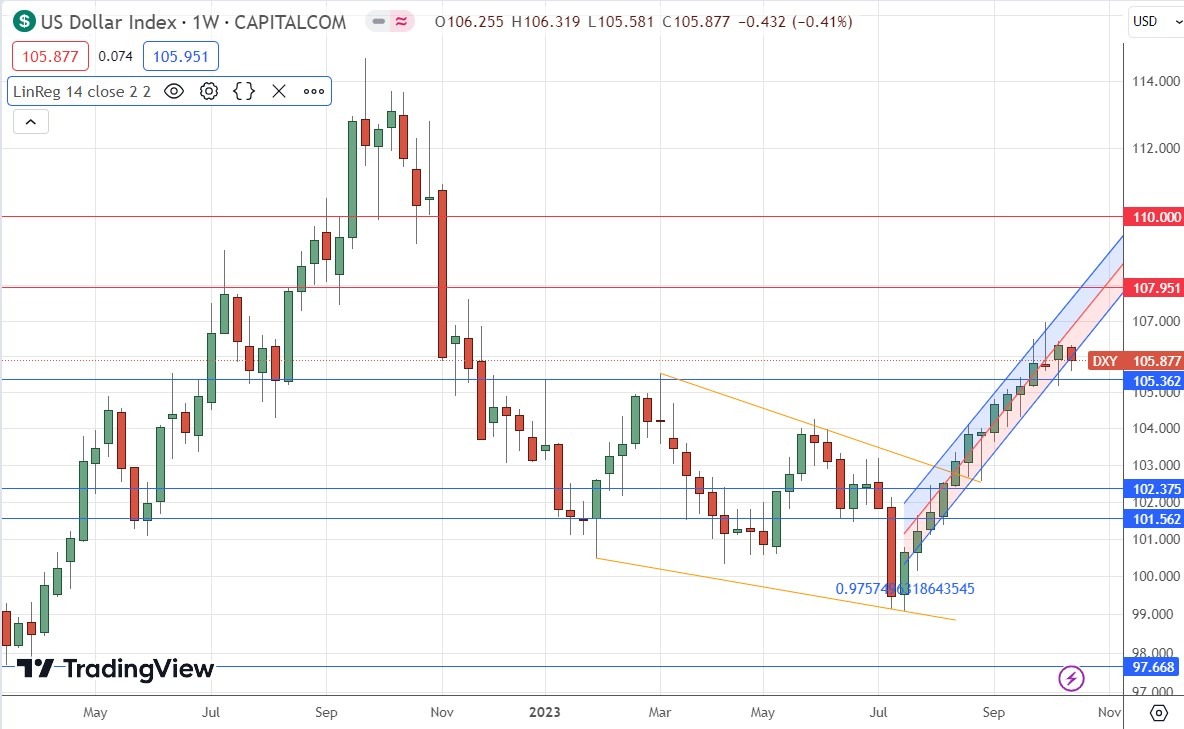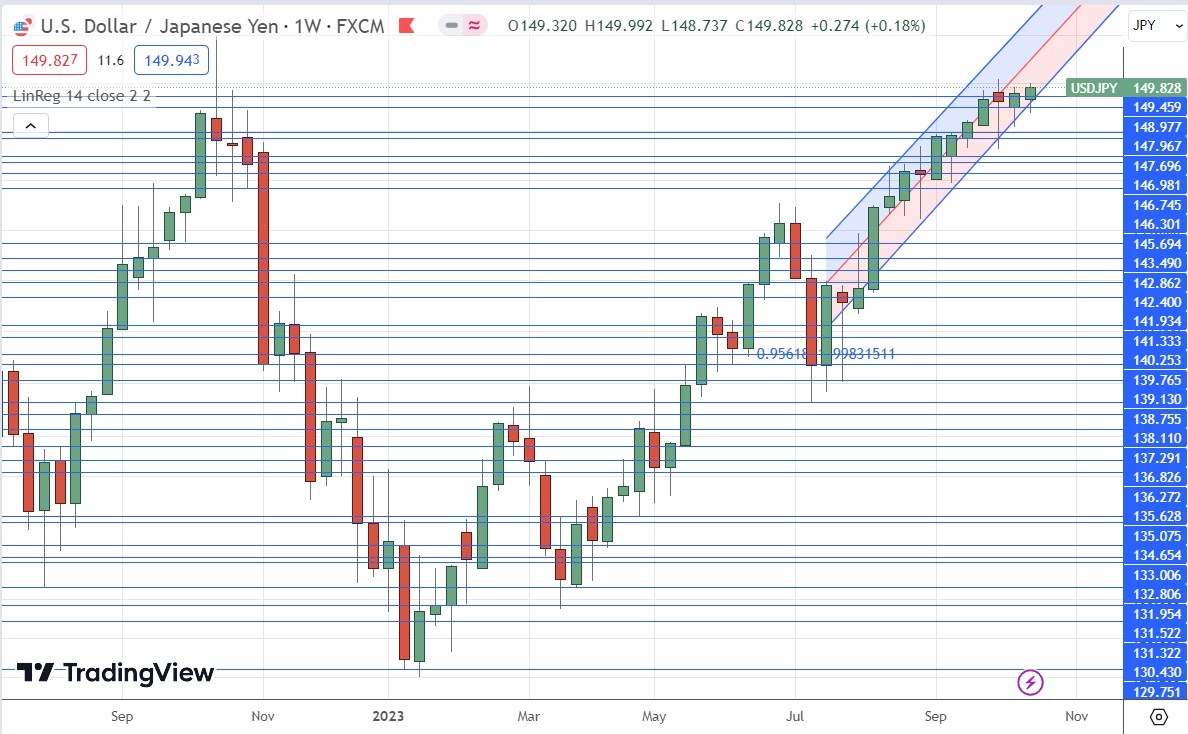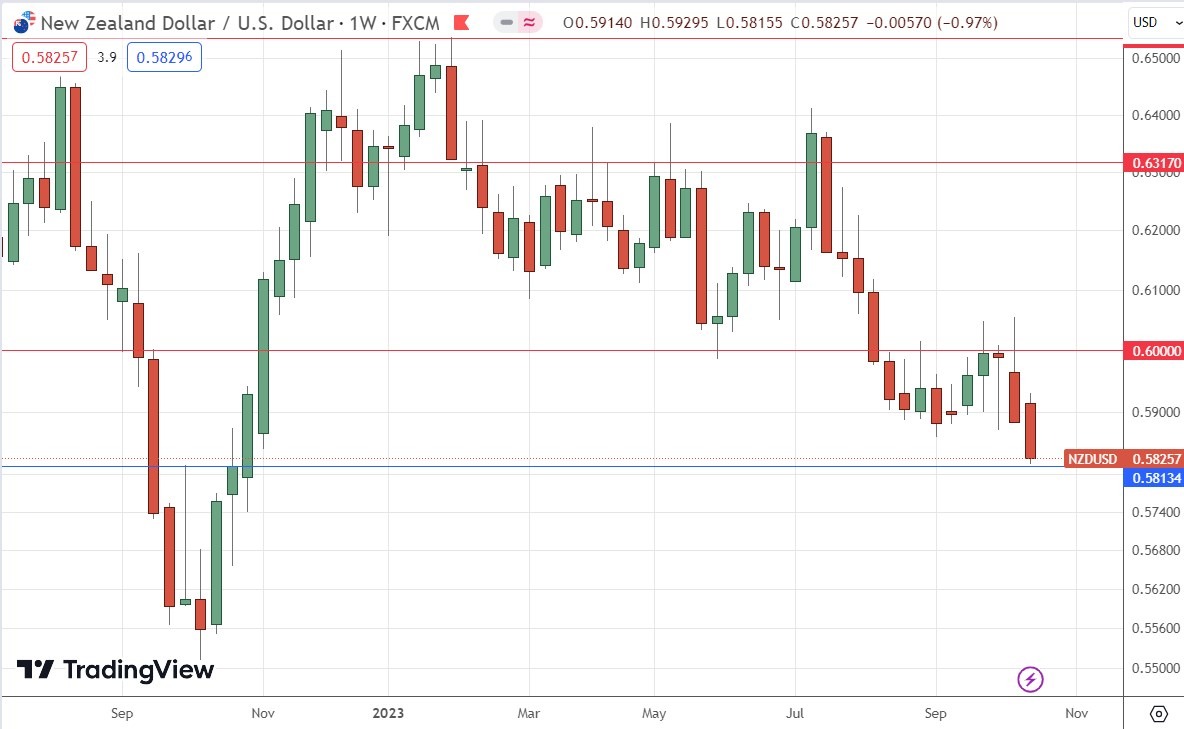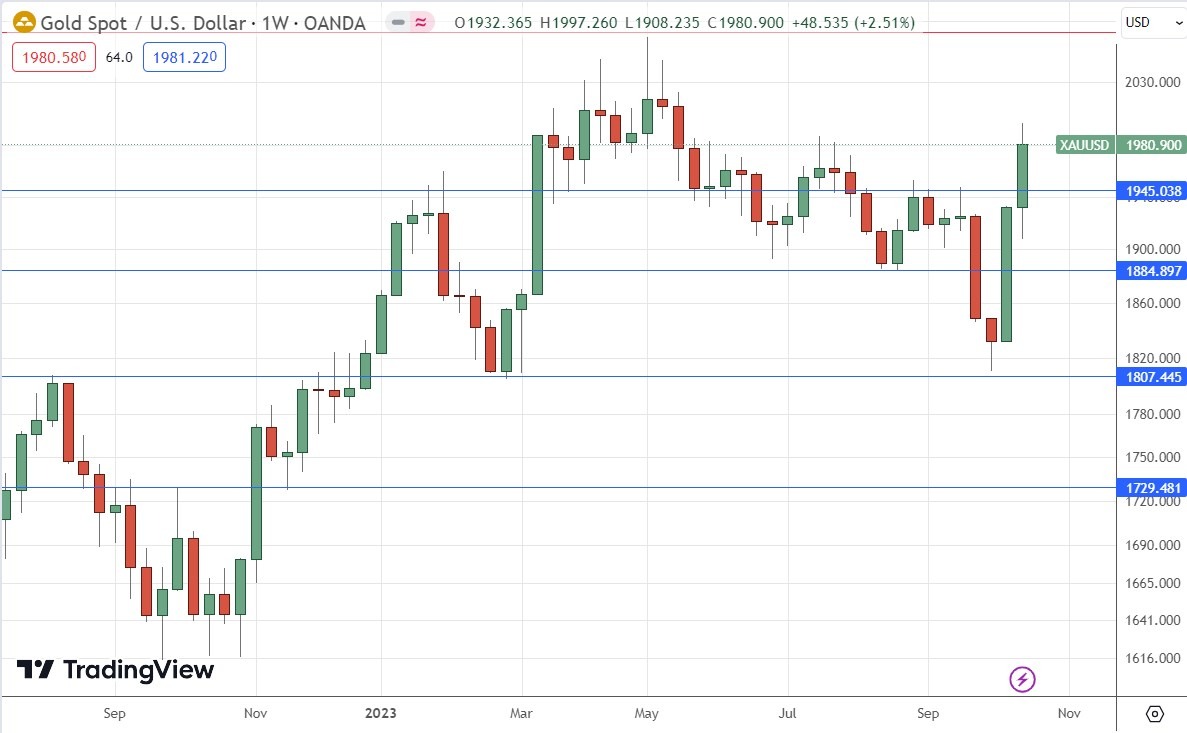Top Forex Brokers
The difference between success and failure in Forex / CFD trading is highly likely to depend mostly upon which assets you choose to trade each week and in which direction, and not on the exact methods you might use to determine trade entries and exits.
So, when starting the week, it is a good idea to look at the big picture of what is developing in the market as a whole, and how such developments and affected by macro fundamentals, technical factors, and market sentiment.
Read on to get my weekly analysis below.
Fundamental Analysis & Market Sentiment
I wrote in my previous piece on 16th October that the best trade opportunities for the week were likely to be:
- Long of the USD/JPY currency pair following a new daily close above ¥150.
- Short of the EUR/USD currency pair following a new daily close below $1.0500.
Neither of these trades is set up.
Last week overall saw a resumption of risk-off sentiment, driven partly by expectations that US interest rates will remain elevated for longer than was expected earlier, and partly by the continuing war in the Middle East between Israel and Gaza which could widen dramatically at any point. The Swiss Franc and Gold were major gainers as safe havens. This is likely to continue as the new week begins, with Hezbollah increasing its attacks on Israel from Lebanon, Israel upping its responses, and the USA raising the alert level for its forces in the Middle East, which are being reinforced.
Last week was fairly busy in terms of major data releases, with the major events being the US retail sales and UK CPI releases which showed stronger than expected consumer demand in the US economy and slightly higher than expected inflationary pressures in the UK. However, the major action in the market last week was in stocks and some commodities, with the US Dollar and Japanese Yen not advancing despite their safe haven status.
The other major events last week were releases of Canadian and New Zealand inflation data. These each came in a little lower than expected, which saw the respective currencies weaken.
Last week’s other key data releases were:
- Australian RBA Monetary Policy Meeting Minutes – this did not contain any surprises.
- US Unemployment Claims – came in approximately as expected.
- US Empire State Manufacturing Index – better than expected.
- UK Retail Sales – considerably worse than expected, which is bad news for the British economy.
- Australian Unemployment Rate – slightly better than expected.
The Week Ahead: 23rd October – 27th October
The coming week in the markets is likely to see a higher level of volatility to last week, as there will be a larger number of important economic data releases. This week’s key data releases are, in order of importance:
- US Advance GDP
- US Core PCE Price Index
- European Central Bank Main Refinancing Rate and Monetary Policy Statement
- Bank of Canada Overnight Rate, Rate Statement, and Monetary Policy Report
- Australian CPI
- UK Claimant Count Change
- US Unemployment Claims
- US, German, UK, French PMI Flash Manufacturing & Services data
- US Revised UoM Consumer Sentiment
- German ifo Business Climate
- Speech by Governor of RBA
Technical Analysis
US Dollar Index
The US Dollar Index printed a weak inside bar last week, after making its highest weekly close in 11 months over the previous week. Although the week ended lower, this technically only looks like a temporary consolidation within the long-term bullish trend.
The price has been rising for almost three months every week except for two weeks within this period, as shown by the linear regression analysis channel which I have added to the price chart below.
What is most interesting is that even though stocks are still falling, and Gold and the Swiss Franc are strengthening as safe havens, the US Dollar is not seeing that flow right now. However, I think it is likely to resume, especially if the war between Israel and Hamas widens, which I believe is likely to happen.
I would only look to take trades in the Forex market which are long of the US Dollar over the coming week.

USD/JPY
The USD/JPY currency pair made its highest weekly close in more than twenty years. However, it did not manage to close above the big round number at ¥150. This number is clearly a major barrier and is being defended, as evidenced by the declining volatility as the price gets closer and closer to it. It is likely to be a pivotal point – a bullish breakout looks more likely than a bearish reversal, and it could be explosive as it is taking a while to happen. However, bulls should be wary of the Bank of Japan intervening to buy the Yen if and when it gets above ¥150.
I still see this currency pair as a long-term buy due to the very loose monetary policy of the Bank of Japan, as well the long-term downwards trend in the Japanese Yen.
The US Dollar is also relatively strong even though it declined over the past week, and I think will be boosted even more if the war in the middle east widens this week, which markets are seeming to discount, so I see the chance for a surprise as to the upside.
I would enter a new long trade in this currency pair only after a firmly bullish daily close above ¥150.

NZD/USD
The NZD/USD currency pair declined last week, printing a solid bearish candlestick which made the lowest weekly close seen in 11 months. The price closed very near the low of the week’s range. These are bearish signs.
There has been a long-term bearish trend in the Kiwi since the start of 2023, although it has been a slow and choppy trend, as can be seen in the weekly price chart below.
The Kiwi is notably weak, similar to the Australian Dollar, but even weaker. This is partly due to risk-off sentiment in the market, but also due to the strong economic downturn taking place in China, as China is a major trading partner of New Zealand.
Bears should be wary of the support level shown in the price chart below at $0.5813.

Gold
Gold was again the standout market gainer of last week, after trading at long-term lows very close to an area of support confluent with the round number at $1800 only two weeks ago.
If you look at the price chart below, you can see how strong and impulsively bullish the past two weeks have been, as the rise cuts quite easily through a long-term area where the price has spent a lot of time within.
The price rose very strongly, and after reaching its highest level since May earlier this year, pulled back a bit. However, it still made its highest weekly close in
Another reason why the rise in Gold is notable is that stock markets, with which Gold is usually highly positively correlated, ended last week lower, so it seems that Gold is acting as a safe haven and a hedge against the middle east war widening. I think the markets are underestimating the chance of the war widening, so Gold could be a good hedge against that.
The problem with going long of Gold now is that the move feels very over-extended. A key metric used to measure trends by hedge funds, the 50-day and 100-day simple moving average crossover, has not yet happened to the bullish side in Gold.
There is also a good chance that there will be strong natural resistance to further rises above the big round number at $2,000.
However, I would be prepared to enter a new long trade in Gold if we get a strongly bullish daily close above $2,000 this week.

Bottom Line
I see the best trading opportunities this week as:
- Long of the USD/JPY currency pair following a strongly bullish daily close above ¥150.
- Long of Gold following a new strongly bullish daily close above $2,000.
- Day trades short of NZD/USD.
Ready to trade our weekly Forex analysis? We’ve made a list of the best brokers to trade Forex worth using.
